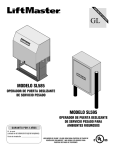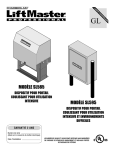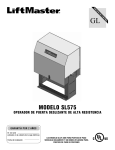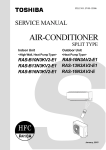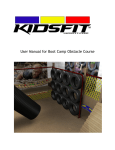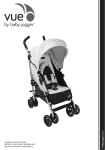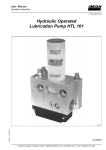Download LiftMaster SL585 User's Manual
Transcript
CO NT RO LL ER GL BO AR D MODEL SL585 HEAVY DUTY SLIDE GATE OPERATOR MODEL SL595 2 YEAR WARRANTY Serial # ________________________ (located on electrical box cover) Installation Date __________________ HEAVY DUTY, HARSH ENVIRONMENT SLIDE GATE OPERATOR MODELS SL585 AND SL595 ARE FOR VEHICULAR PASSAGE GATES ONLY AND ARE NOT INTENDED FOR PEDESTRIAN PASSAGE GATE USE TABLE OF CONTENTS OPERATOR SPECIFICATIONS IMPORTANT NOTES Carton Inventory . . . . . . . . . . . . . . . . . . . . . . . . . . . . . . . . . . . . .2 Operator Dimensions and Horsepower Chart . . . . . . . . . . . . . . .3 UL325 Model Classifications . . . . . . . . . . . . . . . . . . . . . . . . . . . .4 • BEFORE attempting to install, operate or maintain the operator, you MUST read and fully understand this manual and follow all safety instructions. • DO NOT attempt repair or service of your commercial door and gate operator unless you are an Authorized Service Technician. OPERATOR WARNINGS Safety Installation Information . . . . . . . . . . . . . . . . . . . . . . . . . .5 Suggested Entrapment Protection Device Locations . . . . . . . . . .6 Safety Precautions for Open Roller Gates . . . . . . . . . . . . . . . . . .7 Warning Sign Placement . . . . . . . . . . . . . . . . . . . . . . . . . . . . . . .7 WARNING WIRING Mechanical Power Wiring Installation . . . . . . . . . . . . . . . . . . . . . . . . . . . . . .8 CAUTION WARNING WARNING Electrical WARNING CAUTION INSTALLATION WARNING Pad Mounting (SL585 & SL595) . . . . . . . . . . . . . . . . . . . . . . . . .9 Post Mounting (SL585 & SL595) . . . . . . . . . . . . . . . . . . . . . . .10 Install Gate Bracket and Drive Chain . . . . . . . . . . . . . . . . . . . . .11 On/Off Switch Power Wiring . . . . . . . . . . . . . . . . . . . . . . . . . . .12 Manual Disconnect . . . . . . . . . . . . . . . . . . . . . . . . . . . . . . . . . .12 CAUTION ADJUSTMENT Limit Switch Adjustment . . . . . . . . . . . . . . . . . . . . . . . . . . . . . .13 RPM Sensor Adjustment (Hall Effect) . . . . . . . . . . . . . . . . . . . .13 Gate System Test Procedures . . . . . . . . . . . . . . . . . . . . . . . . . .13 Vent Plug . . . . . . . . . . . . . . . . . . . . . . . . . . . . . . . . . . . . . . . . . .14 UL325 Entrapment Protection . . . . . . . . . . . . . . . . . . . . . . .14-15 Control Board Illustration . . . . . . . . . . . . . . . . . . . . . . . . . . . . .15 Program Settings . . . . . . . . . . . . . . . . . . . . . . . . . . . . . . . . . . .16 Control Connection Diagrams . . . . . . . . . . . . . . . . . . . . . . . . . .17 Accessory Wiring . . . . . . . . . . . . . . . . . . . . . . . . . . . . . . . . .18-19 Sequenced Access Management System . . . . . . . . . . . . . . . . .20 When you see these Safety Symbols and Signal Words on the following pages, they will alert you to the possibility of SERIOUS INJURY or DEATH if you do not comply with the warnings that accompany them. The hazard may come from something mechanical or from electric shock. Read the warnings carefully. When you see this Signal Word on the following pages, it will alert you to the possibility of damage to your gate and/or the gate operator if you do not comply with the cautionary statements that accompany it. Read them carefully. OPERATION AND MAINTENANCE Operator Maintenance . . . . . . . . . . . . . . . . . . . . . . . . . . . . . . . .21 Friction Clutch . . . . . . . . . . . . . . . . . . . . . . . . . . . . . . . . . . . . . .22 Solenoid Actuated Brake . . . . . . . . . . . . . . . . . . . . . . . . . . . . . .22 Control Board Programming and Features . . . . . . . . . . . . . .22-23 Troubleshooting . . . . . . . . . . . . . . . . . . . . . . . . . . . . . . . . . .24-25 Single Phase Schematic . . . . . . . . . . . . . . . . . . . . . . . . . . . . . .26 Single Phase Wiring Diagram . . . . . . . . . . . . . . . . . . . . . . . . . .27 Three Phase Schematic . . . . . . . . . . . . . . . . . . . . . . . . . . . . . . .28 Three Phase Wiring Diagram . . . . . . . . . . . . . . . . . . . . . . . . . . .29 CARTON INVENTORY Before beginning your installation check that all components were provided and received undamaged. Refer to list below for factory provided parts. HARDWARE KIT SL585/SL595 (K77-34846) REPAIR PARTS Notes . . . . . . . . . . . . . . . . . . . . . . . . . . . . . . . . . . . . . . . . . . . . .30 Electrical Boxes . . . . . . . . . . . . . . . . . . . . . . . . . . . . . . . . . . . . .31 Repair Parts - Model SL585 . . . . . . . . . . . . . . . . . . . . . . . . . . .32 Illustrated Parts - Model SL585 . . . . . . . . . . . . . . . . . . . . . . . . .33 Repair Parts - Model SL595 . . . . . . . . . . . . . . . . . . . . . . . . . . .34 Illustrated Parts - Model SL595 . . . . . . . . . . . . . . . . . . . . . . . . .35 Safety Accessories for Secondary Entrapment Protection . . . .36 Notes . . . . . . . . . . . . . . . . . . . . . . . . . . . . . . . . . . . . . . . . . . . . .37 Warranty . . . . . . . . . . . . . . . . . . . . . . . . . . . . . . . . . . . . . . . . . .38 Service Information . . . . . . . . . . . . . . . . . . . . . . . . . . . . . . . . . .39 Description Safety Gate Brochure Gate Bracket Take-Up Bolt Nickel Plated Chain #50 U-Bolt 2" 5/16-18 U-Bolt 3" 3/8-16 Square Head Set Screw 7/16-14 Hex Nut 1/2-13 Flange Nut 5/16"-18 Flange Nut 3/8"-16 Flat Washer 3/8" Flat Washer 1/2" Lock Washer 1/2" 2 Qty. 1 2 2 1 4 4 4 4 8 8 8 4 4 O P E R AT O R D I M E N S I O N S A N D H O R S E P O W E R C H A R T MODEL SL585 • 1/2 HP Motor Maximum Gate Speed – 11"/sec. (27.9 cm/sec.) Maximum Gate Weight – 1000 lbs. (453.6 kg) Maximum Cantilever Gate Width – 25 ft. (7.6 m) Maximum Overhead Roller Gate Width – 45 ft. (13.7 m) Maximum V-Track Gate Width – 35 ft. (10.7 m) 28.9" (73.4 cm) 27.5" (69.9 cm) • 1 HP Motor Maximum Gate Speed – 11"/sec. (27.9 cm/sec.) Maximum Gate Weight – 1600 lbs. (725.8 kg) Maximum Cantilever Gate Width – 35 ft. (10.7 m) Maximum Overhead Roller Gate Width – 70 ft. (21.3 m) Maximum V-Track Gate Width – 50 ft. (15.2 m) 17.2" (43.7 cm) 37.7" (95.8 cm) 14.1" (35.8 cm) 12.9" (32.8 cm) 14.9" (37.9 cm) Opposite Gate Side MODEL SL595 • 1/2 HP Motor Maximum Gate Speed – 12"/sec. (30.5 cm/sec) Maximum Gate Weight – 1100 lbs. (499 kg) Maximum Cantilever Gate Width – 25 ft. (7.6 m) Maximum Overhead Roller Gate Width – 45 ft. (13.7 m) Maximum V-Track Gate Width – 35 ft. (10.7 m) 16.5" (41.9 cm) 13.5" (34.3 cm) 24" (61 cm) • 1 HP Motor Maximum Gate Speed – 12"/sec. (30.5 cm/sec) Maximum Gate Weight – 1700 lbs. (771.1 kg) Maximum Cantilever Gate Width – 35 ft. (10.7 m) Maximum Overhead Roller Gate Width – 70 ft. (21.3 m) Maximum V-Track Gate Width – 50 ft. (15.2 m) 30" (76.2 cm) • 2 HP Motor Maximum Gate Speed – 12"/sec. (30.5 cm/sec) Maximum Gate Weight – 2500 lbs. (1134 kg) Maximum Cantilever Gate Width – 45 ft. (13.7 m) Maximum Overhead Roller Gate Width – 90 ft. (27.4 m) Maximum V-Track Gate Width – 60 ft. (18.3 m) 12" Min. (30.5 cm) Gate Side 3 22.5" (57.2 cm) Allow For Door Opening 3" (7.6 cm) Dia. Pipe (Not Provided) U L 3 2 5 M O D E L C L A S S I F I C AT I O N S CLASS I – RESIDENTIAL VEHICULAR GATE OPERATOR A vehicular gate operator (or system) intended for use in a home of one-to four single family dwellings, or a garage or parking area associated therewith. CLASS II – COMMERCIAL/GENERAL ACCESS VEHICULAR GATE OPERATOR A vehicular gate operator (or system) intended for use in a commercial location or building such as a multi-family housing unit (five or more single family units) hotel, garage, retail store or other building servicing the general public. CLASS III – INDUSTRIAL/LIMITED ACCESS VEHICULAR GATE OPERATOR A vehicular gate operator (or system) intended for use in a industrial location or building such as a factory or loading dock area or other location not intended to service the general public. CLASS IV – RESTRICTED ACCESS VEHICULAR GATE OPERATOR A vehicular gate operator (or system) intended for use in a guarded industrial location or building such as an airport security area or other restricted access locations not servicing the general public, in which unauthorized access is prevented via supervision by security personnel. UL325 ENTRAPMENT PROTECTION REQUIREMENTS SAFETY ACCESSORY SELECTION All UL325 compliant LiftMaster gate operators will accept external entrapment protection devices to protect people from motorized gate systems. UL325 requires that the type of entrapment protection correctly matches each gate application. Below are the six types of entrapment protection systems recognized by UL325 for use on this operator. GATE OPERATOR ENTRAPMENT PROTECTION UL325 Installation Class ENTRAPMENT PROTECTION TYPES Type A: Inherent obstruction sensing system, self-contained within the operator. This system must sense and initiate the reverse of the gate within two seconds of contact with a solid object. Type B1: Connections provided for a non-contact device, such as a photoelectric eye can be used as a secondary protection. Type B2: Connections provided for a contact sensor. A contact device such as a gate edge can be used for secondary protection. Type C: Inherent adjustable clutch or pressure relief valve. Type D: Connections provided for a control requiring continuous pressure to operate the operator open and close. Type E: Built-in audio alarm. Examples include sirens, horns or buzzers. Moving Gate Can Cause Injury or Death NOTE: UL requires that all installations must KEEP CLEAR! Gate may move at any time without prior warning. have warning signs placed in plain view on Do not let children operate the gate or play in the gate area. both sides of the gate to warn pedestrians of This entrance is for vehicles only. Pedestrians must use separate entrance the dangers of motorized gate systems. Slide Gate Operator Swing & Gate Barrier (Arm) Operator Primary Type Secondary Type Primary Type Secondary Type Class I & II A B1, B2 or D A or C A, B1, B2, or C Class III A, B1 or B2 A, B1, B2, D or E A, B1, B2 or C A, B1, B2, C, D or E Class IV A, B1, B2 or D A, B1, B2, D or E A, B1, B2, C or D A, B1, B2, C, D or E The chart above illustrates the entrapment protection requirements for each of the four UL325 classes. In order to complete a proper installation you must satisfy the entrapment protection chart shown above. That means that the installation must have one primary means of entrapment protection and one independent secondary means of entrapment protection. Both primary and secondary entrapment protection methods must be designed, arranged or configured to protect against entrapments in both the open and close directions of gate travel. For Example: For a slide gate system that is installed on a single-family residence (UL325 Class I) you must provide the following: As your primary type of entrapment protection you must provide Type A inherent (built into the operator) entrapment sensing and at least one of the following as your secondary entrapment protection: Type B1- Non-contact sensors such as photoelectric eyes, Type B2- Contact sensors such as gate edges or Type D- Constant pressure control. 4 S A F ET Y I N S TA L L AT I O N I N F O R M AT I O N 1. Vehicular gate systems provide convenience and security. Gate systems are comprised of many component parts. The gate operator is only one component. Each gate system is specifically designed for an individual application. 2. Gate operating system designers, installers and users must take into account the possible hazards associated with each individual application. Improperly designed, installed or maintained systems can create risks for the user as well as the bystander. Gate systems design and installation must reduce public exposure to potential hazards. 3. A gate operator can create high levels of force in its function as a component part of a gate system. Therefore, safety features must be incorporated into every design. Specific safety features include: • Gate Edges • Guards for Exposed Rollers • Photoelectric Sensors • Screen Mesh • Vertical Posts • Instructional and Precautionary Signage 4. Install the gate operator only when: a. The operator is appropriate for the construction and the usage class of the gate. b. All openings of a horizontal swing gate are guarded or screened from the bottom of the gate to a minimum of 4' (1.2 m) above the ground to prevent a 2-1/4" (57.15 mm) diameter sphere from passing through the openings anywhere in the gate, and in that portion of the adjacent fence that the gate covers in the open position. c. All exposed pinch points are eliminated or guarded, and guarding is supplied for exposed rollers. 5. The operator is intended for installation only on gates used for vehicles. Pedestrians must be supplied with a separate access opening. 6. The gate must be installed in a location so that enough clearance is supplied between the gate and adjacent structures when opening and closing to reduce the risk of entrapment. Swinging gates shall not open into public access areas. 7. The gate must be properly installed and work freely in both directions prior to the installation of the gate operator. 8. Controls must be far enough from the gate so that the user is prevented from coming in contact with the gate while operating the controls. 9. Controls intended to be used to reset an operator after 2 sequential activations of the entrapment protection device or devices must be located in the line of sight of the gate, or easily accessible controls shall have a security feature to prevent unauthorized use. 10. All warning signs must be installed where visible, on each side of the gate. 11. For a gate operator utilizing a non-contact sensor: a. See instructions on the placement of non-contact sensor for each type of application. b. Care shall be exercised to reduce the risk of nuisance tripping, such as when a vehicle trips the sensor while the gate is still moving. c. One or more non-contact sensors shall be located where the risk of entrapment or obstruction exists, such as the perimeter reachable by a moving gate or barrier. 12. For a gate operator utilizing a contact sensor such as an edge sensor: a. A hard wired contact sensor shall be located and its wiring arranged so the communication between the sensor and the gate operator is not subject to mechanical damage. b. A wireless contact sensor such as the one that transmits radio frequency (RF) signals to the gate operator for entrapment protection functions shall be located where the transmission of the signals are not obstructed or impeded by building structures, natural landscaping or similar obstruction. A wireless contact sensor shall function under the intended end-use conditions. c. One or more contact sensors shall be located at the leading edge, trailing edge and post mounted both inside and outside of a vehicular horizontal slide gate. d. One or more contact sensors shall be located at the bottom edge of a vehicular vertical lift gate. e. One or more contact sensors shall be located on the inside and outside leading edge of a swing gate. Additionally, if the bottom edge of a swing gate is greater than 6" (152 mm) above the ground at any point in its arc of travel, one or more contact sensors shall be located on the bottom edge. 5 S U G G E S T E D E N T R A P M E N T P R O T E C T I O N D E V I C E LO C AT I O N S GATE SYSTEM (MASTER/SECOND SLIDE GATE) Open Edge Gate 1 Photo Eyes for Open Cycle Close Edge Run Twisted Wire from Loop to Operator STREET Seal Loops Interrupt (Safety) Loop Gate 2 1-1/2" (37 mm) 4' (1.2 m) Typical Open Edge 4' (1.2 m) Typical Loop Wire Layer Interrupt (Safety) Loop 1/4" (6 mm) or Larger Depending on Loop Wire Size COMPLEX OR PARKING LOT 6' (1.8 m) 12' (3.7 m) 4' (1.2 m) Typical Photo Eyes for Close Cycle Photo Eyes for Open Cycle GATE SYSTEM (COMMERCIAL SLIDE GATE) Telephone Entry System Open Edge Close Edge STREET Run twisted wire from Loop to Operator* 4' 8' Interrupt (Safety) Loop Photo eye for close cycle Photo eye for open cycle Seal Loops* 1-1/2" 4' Typical 4' Typical 4' Typical Interrupt (Safety) Loop COMPLEX OR PARKING LOT 6 Loop wire* layer 1/4" or larger for Loop wire width depending on Loop wire size SAFETY PRECAUTIONS FOR OPEN ROLLER GATES Gate Edge on Rear of Gate for Open Direction WARNING • Injuries occur when people get their hands or feet caught between the top or bottom of the gate and the gate roller. These potential pinch-points should be guarded against at all times. Enclosed style gate tracks are available for refitting of these rollers from many fence suppliers. Also, roller guards are available for installing over the rollers. • UL325 requires that, when used, contact sensors shall be located at the leading edge, trailing edge, and be post mounted both inside and outside of a vehicular horizontal slide gate. Non-contact sensors such as photo eyes must protect during both open and close gate cycles. • Injuries occur when people put their hands and arms through openings in the grill while the gate is operating. They cannot retract their arm and it gets caught between the moving gate grill and the stationary fence post or fence. This potential hazard can be averted by placing a 4' (1.2 m) screen mesh on the gate to prevent access through openings anywhere the gate may travel. See Safety Brochure for details. To prevent entrapment injuries, mount controls at least 6' (1.8 m) from the gate or any moving parts of the gate. CAUTION Photo Beam for Open Direction Gate Edge on Fence Post for Open Direction Gate Edge On Leading Edge of Gate For Close Direction WARNING Unit Additional Post Mounted Gate Edge for Close Direction WARNING Photo Beam for Close Direction Additional Post Mounted Gate Edge for Open Direction Pinch-Point Hazard Always Test Gate Edges And Photo Beams Anytime They Are Adjusted Or Serviced Pinch-Point Hazard Gate Edge For Open Direction Gate Edge For Close Direction Gate Edge Vertical Post Placed On Both Sides of the Exposed Rollers Can Prevent Hands From Reaching These Pinch-points Gate Edge for Close Direction DO NOT MOUNT ACCESSORIES THAT ARE ACCESSIBLE THROUGH GATE! WARNING SIGN PLACEMENT WARNING WARNING To prevent SERIOUS INJURY or DEATH from a moving gate: • Install Warning signs on EACH side of gate in PLAIN VIEW. • Permanently secure each Warning sign in a suitable manner using fastening holes. CAUTION WARNING NOT FOR USE AS PEDESTRIAN PASSAGE! This operator is intended for vehicular use only. To prevent INJURY to pedestrians, a separate pedestrian access should be supplied, visible from the gate. Locate the pedestrian access where there is not a chance of INJURY at any point during full movement of the gate. Moving Gate Can Cause Injury or Death KEEP CLEAR! Gate may move at any time without prior warning. Do not let children operate the gate or play in the gate area. This entrance is for vehicles only. Pedestrians must use separate entrance 7 NING W IRING WARNING ION WARNING To reduce the risk of SEVERE INJURY or DEATH: • ANY maintenance to the operator or in the area near the operator MUST not be performed until disconnecting the electrical power and locking-out the power via the operator power switch. Upon completion of maintenance the area MUST be cleared and secured, at that time the unit may be returned to service. • Disconnecting power at the fuse box BEFORE proceeding. Operator MUST be properly grounded and connected in accordance with local electrical codes. NOTE: The operator should be on a separate fused line of adequate capacity. • ALL electrical connections MUST be made by a qualified individual. • DO NOT install any wiring or attempt to run the operator without consulting the wiring diagram. We recommend that you Install an optional reversing edge BEFORE proceeding with the control station installation. • ALL power wiring should be on a dedicated circuit and well protected. The location of the power disconnect should be visible and clearly labeled. • ALL power and control wiring MUST be run in separate conduit. • BEFORE installing power wiring or control stations be sure to follow all specifications and warnings described below. Failure to do so may result in SEVERE INJURY to persons and/or damage to operator. POWER WIRING INSTALLATION Wiring Specifications (STRANDED COPPER WIRE) On a Dual Gate System, each unit must be installed on ITS OWN separate circuits WIRE GAUGE 6 • 1/2 HP Motor -----• 1 HP Motor---------• 2 HP Motor---------- SINGLE PHASE 115 Vac 230 Vac 230 Vac THREE PHASE 460 Vac 575 Vac 425 ft. (129.5 m) 1845 ft. (562.4 m) 213 ft. (64.9 m) 852 ft. (259.7 m) 2557 ft. (779.4 m) 12789 ft. (3898.1 m) 15987 ft. (4872.8 m) 1278 ft. (389.5 m) 5115 ft. (1559.1 m) 7993 ft. (2436.3 m) 639 ft. (194.8 m) 2557 ft. (779.4 m) 4441 ft. (1353.6 m) 269 ft. (82 m) 1165 ft. (355.1 m) 134 ft. (40.8 m) 537 ft. (163.7 m) 1614 ft. (492 m) 807 ft. (246 m) 403 ft. (122.8 m) 168 ft. (51.2 m) 730 ft. (222.5 m) 84 ft. (25.6 m) 337 ft. (102.7 m) 1012 ft. (308.5 m) 5064 ft. (1543.5 m) 506 ft. (154.2 m) 2025 ft. (617.2 m) 252 ft. (76.8 m) 1012 ft. (308.5 m) 6330 ft. (1929.4 m) 3165 ft. (964.7 m) 1582 ft. (482.2 m) 105 ft. (32 m) 53 ft. (16.2 m) 634 ft. (193.2 m) 316 ft. (96.3 m) 157 ft. (47.9 m) 3964 ft. (1208.2 m) 1982 ft. (604.1 m) 990 ft. (301.8 m) WIRE GAUGE 8 • 1/2 HP Motor -----• 1 HP Motor---------• 2 HP Motor---------- 8072 ft. (2460.4 m) 10089 ft. (3075.1 m) 3228 ft. (983.9 m) 5044 ft. (1537.4 m) 1614 ft. (492 m) 2525 ft. (769.6 m) WIRE GAUGE 10 • 1/2 HP Motor -----• 1 HP Motor---------• 2 HP Motor---------- WIRE GAUGE 12 • 1/2 HP Motor -----• 1 HP Motor---------• 2 HP Motor---------- 458 ft. (139.6 m) 211 ft. (64.3 m) 3171 ft. (966.5 m) 1269 ft. (386.8 m) 634 ft. (193.2 m) NOTE: Calculated using NEC guidelines. Local codes and conditions must be reviewed for suitability of wire installation. All power wiring should be dedicated and protected. Location of primary power disconnect should be labeled. 8 I N S TA L L AT I O N PAD MOUNTING (SL585 ONLY) Figure 1 RETRO-FIT INSTALLATION The operator is shipped from the factory with the lower mounting angles configured out (Figure 1). If you have pad constrictions, either angle can be unbolted and reversed to ‘angle in’. NOTE: If you are replacing an SL580 and wish to use the same pad mounting hardware, the gate side mounting angle must be installed angle in. Angle Out Angle In Figure 2 NEW INSTALLATION CONCRETE PAD PREPARATION: 1. Lay out concrete pad. (Figure 2). 2. Locate electrical conduit, as required, prior to pouring concrete. 3. Pour concrete pad. 4. Secure operator (Figure 3) to the concrete pad using four 1/2" (1.3 cm) concrete anchors (not provided). Rear of Gate or Back Frame Fence Line 1" (2.5 cm) 4" (10.2 cm) 10-7/8" (27.6 cm) 18" (45.7 cm) 21-1/8" (53.7 cm) 7" (17.8 cm) 36" (91.4 cm) Concrete Anchor Holes Figure 3 Using Suitable Hardware To Secure Operator To Concrete Anchors Concrete Pad 1/2" (12.7 mm) Concrete Anchors (4 Required) Drive and Idler SprocketToward Gate Side Power and Control Wiring Should Be Run In Separate Conduit 2" to 4" (5.1 to 10.2 cm) Above Grade Depth Required By Local Codes or Below Frost Line 9 POST MOUNTING (SL585 AND SL595) RETRO-FIT INSTALLATION The operators come from the factory configured to mount to an inside the frame post mount dimension of 26" (outside to outside of posts). The frame comes slotted to accommodate posts 24 1/8" to 26", outside to outside (Figure 1). NOTE: If you are replacing a SL580, the frame will require adjustment to 24 1/8". Figure 1 NEW INSTALLATION (FIGURES 2 AND 3) 1. Locate and anchor two posts made of 3" (7.6 cm) outer diameter heavy walled pipe. Posts should be parallel and square to the gate. 2. Locate electrical conduit, as required, prior to pouring concrete. 3. Secure operator to posts using four 3" (7.6 cm) U-bolts and hardware provided. 26" (66 cm) Post to Post Adjustment 24 1/8" (61 cm) End Post Figure 2 Fence Line Figure 2 Gate 8.5" (21.6 cm) 6" (15.2 cm) Drive and Idler Sprocket Toward Gate Side 26" (66 cm) Outside To Outside 3" (7.6 cm) Outside Diameter Heavy Wall Fence Pipe Angle Bracket 14" (35.6 cm) Min. 3" (7.6 cm) U-bolt (4 required) Ground Level Depth As Required By Local Codes or Below Frost Line SL585 ONLY Power and Control Wiring Should Be Run In Separate Conduit Figure 3 End Post Drive and Idler Sprocket Toward Gate Side Figure 3 Fence Line 3" (7.6 cm) U-bolt (4 required) Gate 8.5" (21.6 cm) 24" (61 cm) 6" (15.2 cm) Inside to inside 3" (7.6 cm) Outside Diameter Heavy Wall Fence Pipe 12" (30.5 cm) Minimum From Ground 39" (99.1 cm) Min. Power and Control Wiring Should Be Run In Separate Conduit Ground Level Depth As Required By Local Codes or Below Frost Line SL595 ONLY SL595 ONLY 10 WARNING INSTALL GATE BRACKET AND DRIVE CHAIN WARNING CAUTION WARNING Figure 1 “Outside” To prevent damage to the operator or gate, DO NOT drive the limit (nuts) actuators on the shaft past their normal positions. Gate “Inside” 1. Mount gate brackets to the vertical front and rear posts of the gate (Figure 1). 2. Remove the operator cover or open access door. 3. Locate and engage the manual disconnect and lock it in place (refer to page 12). 4. Connect chain take-up bolt to the end of the chain and attach to the rear gate bracket (Figure 2). 5. Ensure that the drive and idler sprockets are in line with each other. Thread the chain through the plastic chain guide, around drive and idler sprockets, and then through the second plastic chain guide toward front gate bracket (Figure 3). 6. Adjust the chain to proper length and attach second take-up bolt to chain end. Secure the take-up bolt to the front gate bracket as shown. 2" (5.1 cm) U-bolts With Lock Washers and Nuts Anti-Rotation Set Screw Gate Bracket Figure 2 Adjust nuts on chain take-up bolts to remove chain slack. A general rule of thumb is to leave a maximum of 1" (2.5 cm) of chain slack for every 10' (3.1 m) of chain length. Do not overtighten chain. NOTE ABOUT SOME TYPES OF CANTILEVER GATES: With some cantilever gates over 20' (6.1 m) long, you may need to add a brace along the length of the gate to prevent the gate from bowing when chain is tightened. This may also be required on some styles of gates that are constructed out of aluminum. If positioned properly, this brace can also be used as a chain support. * * Gate brackets must be level and centered with bottom of idler sprocket Figure 3 Drive Sprocket Gate Bracket Gate Post Idler Sprocket Idler Sprocket Safety Bracket Insert Chain Through Plastic Guides 11 * AVAILABLE CONDUIT ACCESS FOR THE ELECTRICAL BOX The accessory tray is equipped with several 1-1/2" pass though holes as well as 3/4" and 1" knock outs for conduit connectors. The electrical box is equipped with 3/4" and 1" knock outs for conduit connectors. ON/OFF SWITCH POWER WIRING NOTES: Before running power wiring refer to wiring specifications on page 8 for correct wire gauges. Secure all electrical power connections inside the disconnect switch electrical box. Refer to electrical wiring diagrams on pages 26-29. SINGLE PHASE All single phase 115V/208/230V operators will have the following: • L1 WHITE • L2 BLACK • GROUND, GREEN 115V SINGLE PHASE POWER SWITCH ASSEMBLY THREE PHASE All three phase operators will have the following: • L1 BLACK • L2 BLACK • L3 BLACK • GROUND, GREEN 230V SINGLE PHASE & THREE PHASE POWER SWITCH ASSEMBLY IMPORTANT NOTE: This operator is shipped from the factory as a right hand mounted unit, unit MUST be phased correctly. On three phase operators, power connections must be properly phased. If phased incorrectly, the gate operator will run reversed. To correct this situation, shut off power at main power source and at the operators electrical disconnect switch. Then reverse any two of the three power leads. MANUAL DISCONNECT MODEL SL585 DISENGAGEMENT: RE-ENGAGEMENT: MODEL SL595 DISENGAGEMENT: Rotate disconnect handle 90˚ to disengage. The gate may now be moved manually. Rotate handle back to original position. (Some operator output sprocket rotation may be required for engagement). RE-ENGAGEMENT: Pull the handle to release 12 Open the hinged door and pull the disconnect lever and lock it in place. The gate my now be moved manually. Release the lever and close the door. (Some operator output sprocket rotation may be required for engagement). ADJUSTMENT LIMIT SWITCH ADJUSTMENT WARNING NOTE: Make sure the limit nuts are positioned between the limit switch actuators before proceeding with adjustments. 1. Remove control panel cover and locate the limit switch assembly. 2. Disengage the unit’s manual disconnect (page 12), then manually open the gate to its full open position (Note direction of limit nut travel). 3. Adjust the open limit nut by depressing the retaining bracket to allow nut to spin freely. Adjust open limit nut so that it trips the open limit switch. After adjustment, release plate and ensure it seats fully in slots of both nuts. 4. Manually close the gate to its full closed position. 5. Disengage the retaining bracket and rotate the close limit nut until it trips the close limit switch. 6. Re-engage the retaining bracket into both limit nuts and also re-engage the manual disconnect. To reduce the risk of SEVERE INJURY or DEATH: • Disconnect power BEFORE performing ANY adjustments. CAUTION RPM SENSOR (HALL EFFECT) ADJUSTMENT NOTE: Normally the RPM Sensor (hall effect) does not need adjustment, but may go out of alignment due to shipping vibration or rough handling. These operators use an internal entrapment protector system. This system consists of the control board, magnet, and RPM sensor (hall effect). It may become necessary to adjust the sensor for correct alignment. To do so please perform the following steps: 1. The sensor must be Vertical Adjustment Screws centered over the Horizontal Adjustment magnet wheel. Adjust Screws with horizontal screws. 2. The sensor must be RPM Sensor (Hall Effect) level. 3. The sensor air gap .010 - .015" should be adjusted to (.25 - .38 mm) Air Gap .010 - .015 of an inch (.25 - .38 mm). (The Magnet thickness of a business card may be used to gauge the correct distance). Adjust with vertical screws. LIMIT DIRECTION DIRECTION OF GATE TO OPEN OPEN LIMIT CLOSE LIMIT RIGHT (Factory Default) A B LEFT B A Limit Switch Limit Nut A Limit Switch Limit Nut B Retaining Bracket Depressed Plate Each Notch of the Nut Indicates an Estimated 1" (2.5 cm) of Gate Travel GATE SYSTEM TEST PROCEDURES Make sure that the gate’s path is clear from any obstructions and that all associated gate hardware is properly mounted and secured. 1. With the power off, manually move the gate to the fully closed position. 2. At the closed position, turn the power on and observe the GL controller board’s diagnostic and limit LEDs. When power is turned on, these LEDs should flash simultaneously for a few seconds. 3. Locate the 3-button control that is built into the electrical box. 4. Push the open button and observe the operator’s behavior. The gate should begin opening. If the operator fails to open or has difficulty opening, refer to the troubleshooting section. 5. Once at the open limit, the gate will stop. Push the close button and observe the operator’s behavior. If the operator fails to close or has difficulty closing, refer to the troubleshooting section. 6. While the gate is closing, push the stop button. The gate should now stop. 7. Push the close button to return the gate to the fully closed position. 13 INSTALL VENT PLUG 1. Remove fill plug from gear box. 2. Install vented plug provided with the hardware box. 3. Remove relief valve from the new vented plug. Fill Plug Drain Plug UL325 ENTRAPMENT PROTECTION PRIMARY ENTRAPMENT PROTECTION ADJUSTMENTS Force Control Set the force control pot such that the unit will complete a full cycle of gate travel but can be reversed off an obstruction without applying an unreasonable amount of force. On most operators this will be around the middle of the range. Force Control GL Control Board Max Min 5 6 7 8 9 10 SECONDARY ENTRAPMENT PROTECTION ADJUSTMENTS Terminals 9 & 5 - Obstruction While Opening (Edge/Photo Eye Input) Edge Input: See Programming Section on page 15. This input will reverse an opening gate to the close limit. Activating this input when the gate is closing will have no effect. NOT








































